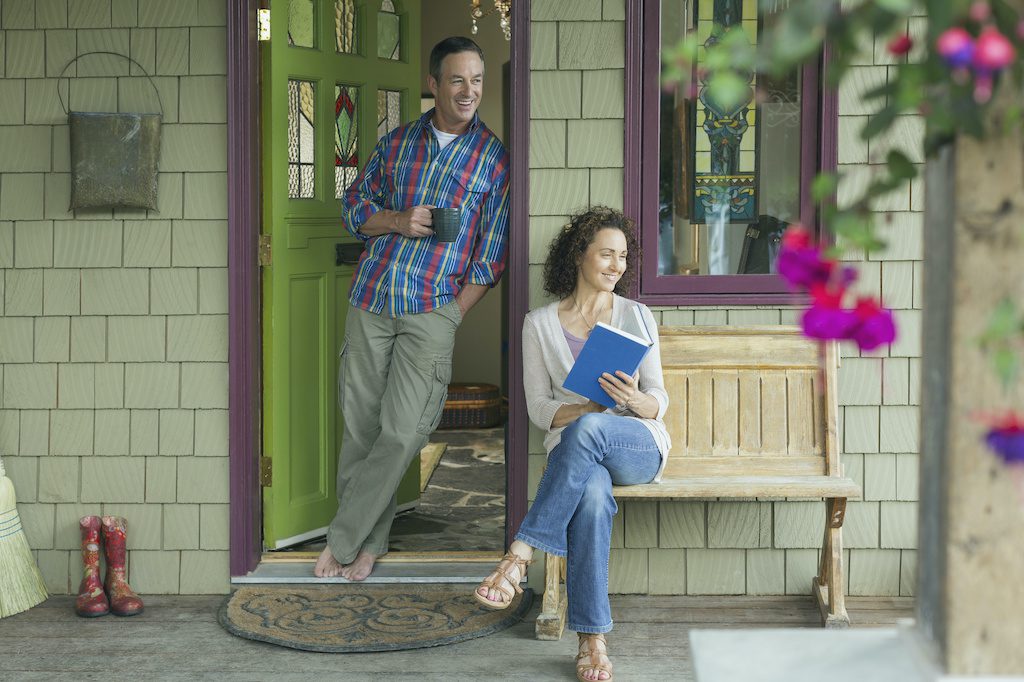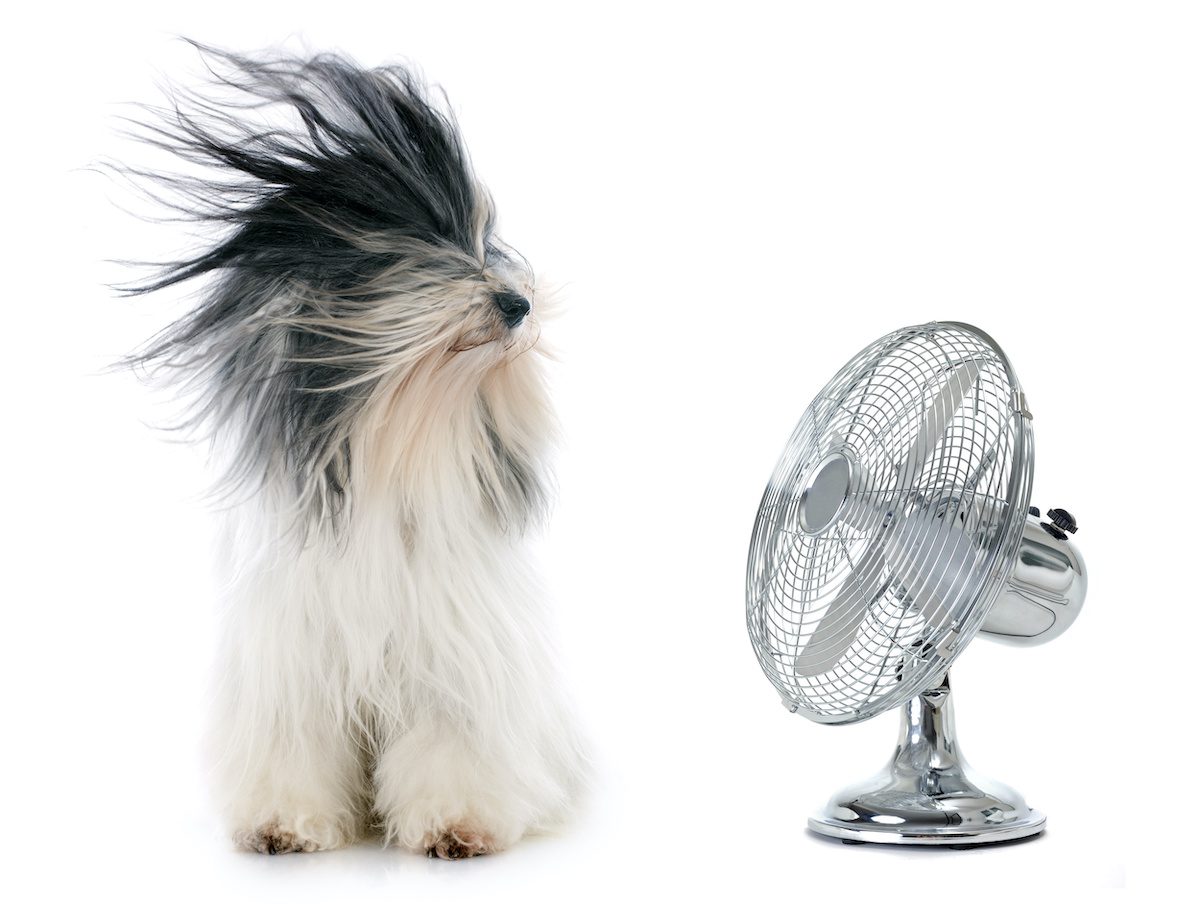
“How to keep your garage cooler?” is an all too common question in our area.
North Alabama residents are no strangers to hot, humid summers. Our hot and humid season lasts for close to 4 months, from the end of May until the end of September, with an average daily high temperature above 81°F. The hottest day of the year in North Alabama is July 22, with an average high of 90°F and low of 72°F.
Although most of you may be able to tolerate the summer weather from the air-conditioned comforts of your interior spaces, you might not have a safe or relaxing summer if you spend time inside your garage. Since most garages don’t connect to a central heating and cooling system, your garage may likely reach high and uncomfortable temperatures in the summer season, increasing your risk of heat stroke and heat stress.
If you plan to spend time in your garage during the hottest months, or if you store items that don’t tolerate heat well in your garage, we invite you to read the following 20+ tips for keeping your garage cooler in the summer months.
We would also like to invite you into our showroom here at Overhead Door™ to view our complete line of insulated and non-insulated garage doors. We understand every home is different. We are there to help answer any questions you may have before you buy. Contact us today!
Quick Options For Keeping your Garage Cooler
• Cool your car before parking it inside.
Anytime you drive your car, it heats up. Especially in the summertime, parking your car in the garage immediately after you arrive home is not a good thing to do. The heat from your vehicle will cause the inside temperature to rise. If you enter the garage and then close the garage door immediately, all of that hot air remains trapped inside of the garage, raising the overall temperature of your garage and its surrounding areas.
As simple as it may sound, park your car outside the garage after driving it on a hot day. Let the car cool off before parking it in your garage.
• Choose the right time to spend time in your garage.
A way to make spending time in the garage more bearable whenever the weather is hot is to choose the most practical time of day to be in there. The morning hours are always the best. Opening the garage doors before going into the garage on a hot day is always good. This will release the trapped heat.
Early evening hours between about 3:00-6:00 p.m. is the least favored time to be in your garage on a hot sunny day.
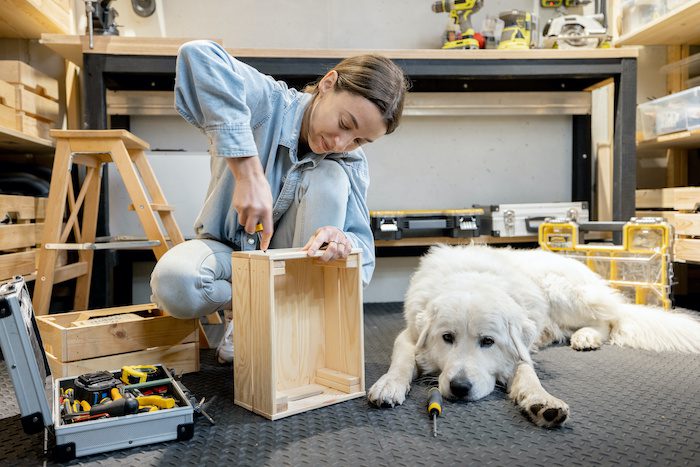
• Leave the garage door open for a few hours.
If you don’t have windows in your garage, another option is to leave the garage door open for a few hours when you want to lower the temperature. This is only recommended if you’re going to be home at the time. Do not leave your garage open and unattended if you plan to leave your home. This is a great way to ventilate a hot garage and let some of that trapped air escape.
If you have a garage door facing north, you’ll find that opening the door lets in cooler air because the northern side of your property gets less sunlight, which means lower temperatures.
If your garage door doesn’t face north, opening it typically brings in a breeze. Air that’s moving will be cooler than air that stands still.
If you prefer your privacy, you can still open doors and windows to cool things off. Instead of opening your garage door all the way, raise it a foot or two off of the ground.
• Leave the windows open to create a breeze.
If possible, opening windows or doors in a manner that creates a cross-breeze is most effective.
When you open the garage’s doors and windows, you create a cross-breeze that significantly cools your space, making it much more comfortable inside for working or just hanging out. It’s important to remember to close everything up when you’re done to prevent anyone from breaking into the garage overnight or while you’re not home.
• Add window coverings. There are many options for window coverings in your garage.
Blackout curtains are helpful and available at most home improvement stores, online, or local department stores. The use of these curtains may be seasonal, keeping in mind that uncovered windows can also cause significant heat gain during summers and heat loss during winters. Light and air are important in keeping your vehicles in good shape and preventing moisture or molds from growing in a garage.
Window film is a good choice for keeping harmful UV rays and heat from filtrating your indoor garage space.
The use of shutters and blinds, etc., might also be another option.
• Declutter your garage for better air flow.
Sure enough, organizing your garage space will promote better air circulation!

• Weatherstripping and caulk.
Proper insulation inside a garage and its garage door do an excellent job keeping hot air out and cold air in during the summer. However, if your doors or windows have any cracks or gaps in their frames, your garage will still heat quickly during the summer, despite the insulation precautions you may have in place. Only a tightly sealed garage will maintain a steady temperature.
Weatherstripping seals the gaps around your garage door and around your window frames, preventing warm drafts from seeping inside.
Even after adding the proper weatherstripping, if you still have gaps in your walls, windows trim, and frames, you may need to caulk the seams and joints. However, be careful not to caulk any seams that allow your garage door to open and close.
• Replace your threshold seal if worn out.
Thresholds are great for filling larger gaps.
We do offer threshold replacement services!
• Move your home improvement projects or hobbies outdoors.
Avoid using items like drills, planers, table saws, or sanders during the heat of the day. Try moving these tasks outdoors instead. Not only will the temperature be more pleasant, but you’ll preserve the air quality in your space as well.
• Seal outlets and switches in the garage.
Electrical outlets and light switch boxes can let in hot air from the outside. Addressing this issue is an inexpensive and simple fix.
• Close the doors when it’s hot outside, especially when the sun is shining on the open side of your garage.
An open garage door with exposed concrete will collect heat. If the sun beats on your concrete floor, it acts as a massive heat sink. The concrete collects the heat and then releases it later.
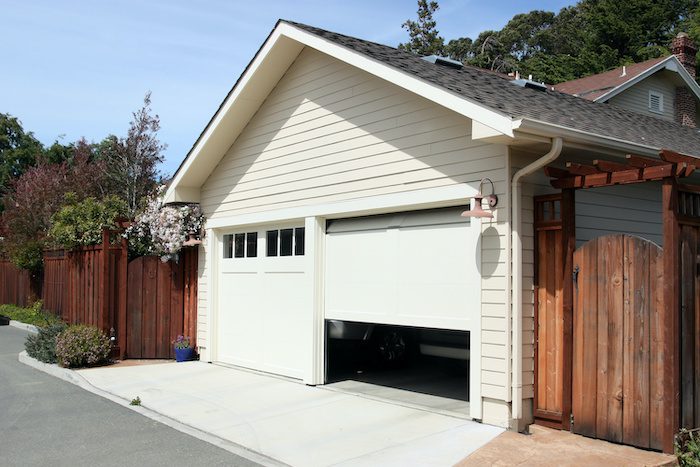
• Use fans to circulate stale air.
Garage fans come in three major types: ceiling fans, floor-standing fans, and wall-mountable or window fans.
If your garage’s ceiling is at least 8 feet high, a ceiling fan is an means of keeping your garage cool in the summertime without causing your energy bill to increase dramatically. You must make sure the blades of the ceiling fans are between 7 and 9 feet above your existing garage floor and between 10 and 12 inches under the existing ceiling. If your garage ceiling is lower, installing a fan is not recommended because it would interfere with your garage door opening and closing. A lower ceiling fan could also prevent you from parking a taller vehicle inside the garage.
An oscillating standing fan is a good choice if you don’t have the right height for a ceiling fan.
If you have existing windows in your garage, you might want to install a window fan to draw cooler air into the garage or expel hot air from the interior garage space. A wall-mountable fan is another option if you don’t have an existing window.
If you go with a fan, choose a fan with industrial-strength. You’ll need one with strong blades that will withstand any debris dropped in a space, such as sawdust from home improvement projects.
• Install a dehumidifier to lower the humidity level in your garage.
The unexpected cooling solution for your garage actually isn’t a cooling solution at all. The use of a dehumidifier in a garage can help remove moisture from the air, leaving your garage feeling cool and dry. While a dehumidifier won’t lower the actual temperature in a garage, it can cause it to feel five to ten degrees cooler because the relative humidity is reduced. By removing moisture from the air, you should notice a slight difference, especially with a good ventilation system already in place.
The level of humidity should not be any higher than 45% to 50% if you want to be comfortable. Make sure that you have a quality dehumidifier that can help to lower the humidity in the garage.
A dehumidifier is also helpful year-round in the garage with its condensation-reducing benefits. All dehumidifiers are not the same.
You will need to do your research to determine which dehumidifier will best fit your needs. There are other factors to consider when installing a dehumidifier in your garage. Condensation on the garage floor, standing water on the garage floor, and evidence of mold of wood rot on the walls and ceiling are a few reasons why you should consider a dehumidifier for your garage. Contact a professional on this.
More Costly Solutions to Keeping your Garage Cooler
• Choose lighter colors for your garage doors and home exterior.
If we keep in mind that light colors reflect heat, while dark colors absorb heat, this would mean that painting your garage door a lighter color, especially if it’s facing west, would keep the interior of your garage cooler. It may also be wise to choose a garage door design that does not include windows or choose tinted windows in order to minimize how much sun heat enters the garage.
• Strategically Place Awnings and Trees.
The sun can beat down on your garage all day long, making it very hot inside. You can strategically plant trees around your yard to shade your garage. The more shade you have around your garage, the cooler it will be.
Another way to reduce your garage’s heat absorption is by installing a retractable awning.
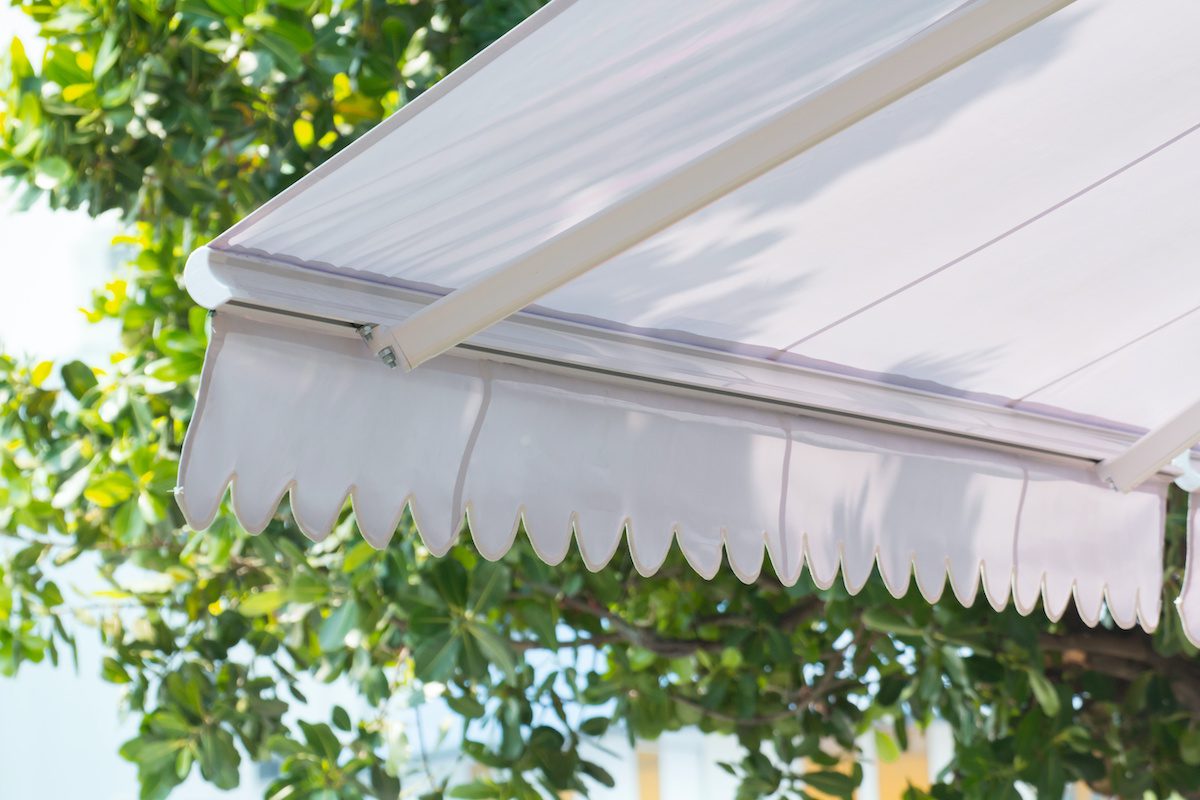
• Upgrade your garage’s ventilation system.
Attic ventilation can be split into either active or passive categories.
Note: Amongst the experts, this is a highly debated discussion. For this reason, we will discuss two categories of attic ventilation and leave the details to professionals in this area. There are thousands of online articles referencing this very topic.
Passive ventilation is normally installed on the roof and requires very little energy consumption when blowing heat from the garage’s attic. They are commonly seen in the form of those spinning turbine roof vents. Passive ventilation systems provide air circulation through natural methods such as thermal buoyancy and air currents. It brings in fresh air while pushing out the old stale air.
Installing an active ventilation system can be more difficult and pricier but also more efficient at removing hot air from the garage because it’s mechanically powered. This type of ventilation system can be installed on the roof and can also be installed in the garage’s walls, preferably opposite the garage door in a high position.
Make sure any ventilation system is installed by a pro. They can use a lot of electricity, and you don’t want to overload your electrical circuits. There are many variants when choosing between the two.
Invest in an air exchange system
By installing an air exchange system, stale air inside the garage is replaced with cool air from outside. They are fairly heavy-duty and are usually mounted to the ceiling and vented outdoors.
If you work with the garage door partially or completely shut, air exchange systems can cool a garage by 10°-20°.
Conceptually similar to home HVAC systems, air exchange systems typically mount to the ceiling of your garage and extract hot air from the space, pushing it into the attic where it will ultimately be forced outside through a vent, fan, or gable. A vent or two installed in a wall or in the garage door itself allows cooler air to replace the hot air that the exchanger has removed from the garage.
Unless you have electrical knowledge and experience, plan to have this type of system installed by a professional.

• Upgrade your insulation to prevent the garage from heating up.
Note: Amongst the experts, this is another highly debated discussion. For this reason, we will discuss three categories of insulation in your garage, and leave the details to professionals in this area. There are thousands of online articles referencing this very topic.
There are three significant areas where you need insulation in your garage. Most garages are missing all three of them.
1. Garage Door Ceiling
One of the first things to consider when upgrading or adding insulation is the garage ceiling, especially if your garage ceiling isn’t finished. This is every important if your house has a bedroom or usable living space above the garage. You can take this opportunity to finish the ceiling with drywall, but if you don’t want to spend the money or time on an extensive project, you can simply staple batt insulation along with the ceiling and then set it in place using netting designed to hold insulation where you want it. The heat from the garage can radiate through the floor, causing the air conditioner has to work overtime to try to keep the house cool.
Does the garage heat rise to the attic or rooms above?
The basic law of thermodynamics says that heat moves from hot places to cooler places. This means if your garage is 115 F and adjoining rooms are 80 F, then the nearby rooms will absorb the heat transfer.
Without a doubt, the heat from the garage will absolutely contribute to high temperatures in the attic space above, as well as any finished adjoining rooms. Hopefully, the ceiling cavity between the garage and the finished spaces is insulted. Please consult the local building codes for your area before adding any insulation between the ceiling of your garage and the attic itself.
2. Garage Door with Quality Insulation
Make sure that you have a garage door that has quality insulation. An insulated garage door is going to make the garage far more energy-efficient. When your time comes to get a new garage door, try choosing one with polyurethane foam insulation. While shopping, look for no thermal bridges, which could cause heat to come into your garage as well. When you choose an insulated quality garage door, it really can make a difference, even when you do not have air conditioning in the garage. Make sure to visit our Thermacore, Courtyard, Impression Steel, and Carriage House Collections from Overhead Door™.
There are options for do-it-yourself insulation kits available for insulating your existing garage door. These are available at your local hardware stores.
VERY IMPORTANT TO READ IF CONSIDERING ADDING
YOUR OWN INSULATION TO YOUR EXISTING GARAGE DOOR
Your garage door has springs that are calibrated to the weight of your door. They are designed to make the door easy to open. When properly balanced, your door should stay put when half open. It should not shoot up or fall down. Garage doors are delicately balanced. Even a small change in weight can upset them. After insulating the door, always make sure your garage door is properly balanced.
Garage door springs are under heavy tension. If you don’t know exactly what you’re doing, hire a professional to balance the door. It’s even more important if you have a motorized garage door opener. The motors are designed for balanced doors. Unbalanced doors can add weight that will wear out the door movement motor.
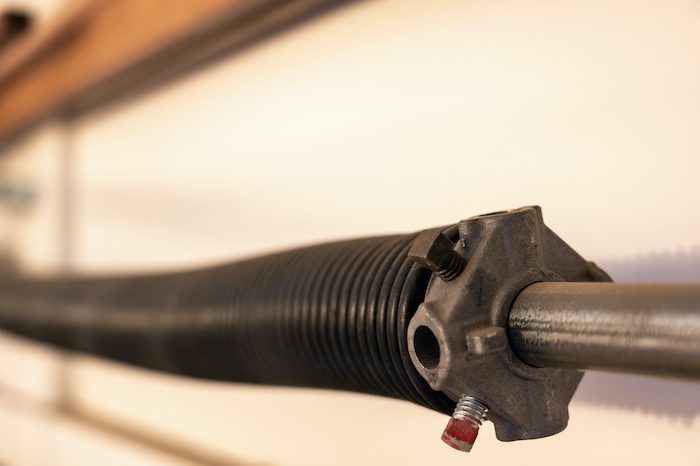
3. Insulate and Drywall your Garage Walls
If the outside of your house is aluminum siding, wood, or stucco, you’ll definitely want to insulate and drywall your garage walls. This will help seal up any air leaks and keep the cool air in and the hot air outside where it belongs. If your garage already has drywall installed, you can consider blown-in insulation. If your garage isn’t finished and doesn’t have drywall, then consider installing batt insulation. It’s cheap and easy to install, but you’ll want to cover it with drywall to prevent children and pets from coming into contact with it.
• Add a Portable air conditioner.
Portable air conditioners are not the best option for everyone. When a garage is not insulated, the air will escape through the walls and garage door, meaning the air conditioning system will have to work extra hard to cool the room.
Once you have your garage insulated, adding air conditioning is the more expensive option of cooling your garage, but it but can be the most effective for bringing garage temperatures down quickly.
If you have a small garage with a window, a window-mounted air conditioner can nicely keep temperatures at a comfortable level while you’re in the garage. For larger garages, but not too large, a portable air conditioner with enough BTUs is more suited.
A mini-split air conditioner is another wonderful cooling option worth considering.
No matter which portable air unit you might choose, the venting of the air conditioning unit is necessary while it’s running because the hot air that gets released needs to have somewhere to go; otherwise, it recirculates through the unit and right back into your garage. In the end, this will defeat your efforts to cool your area.
With a properly installed vent, hot air inside the garage will travel directly from the air conditioning unit, through the vent, and out of the garage.
If there is no window in which to vent the unit, you can consider installing a vent in an exterior wall. This could require you to cut a hole in the wall.
If you choose to use this option, it may just be best to install a thru wall air conditioner, as they are usually cheaper and don’t take up floor space.
If you use your garage as a workshop or a place to work on other hobbies, you’re spending a lot more time there compared to people who only use their garage for storage or to park their cars. If your budget allows, your garage can be fitted for central air conditioning.
• Replace your aging garage door with an insulated garage door.
Whether you have a one, two, three, or even a four-bay garage, a garage door usually makes up one entire wall. For this reason, it is useless to insulate everything else within a garage and leave your garage door uninsulated.
If your garage door needs a replacement, opt for one that features insulation. Insulated doors minimize heat transfer from the outside, allowing your garage to maintain a more comfortable internal temperature. As you search for a new garage door, double-check the R-value. A higher R-value offers greater insulating power, so the door with the highest R-value will resist heat more effectively.
Your Garage Can Now Be a Cooler Place!
We hope you found our “20+ Tips for Keeping Your Garage Cooler” helpful. Taking all or some of these measures is paramount to the success of keeping your garage much cooler in the summer months.
Alert: Don’t close off your garage so much that exhaust fumes can’t escape.
If you are in the market for a new insulated garage door, or a if you have decided that an insulated garage is something you don’t need, we have garage doors available for any scenario. We invite you to visit our garage door collections!
Give us a call to schedule an appointment at our hands-on, active showroom at 256-772-3674. Overhead Door Company of Huntsville/North Alabama™ has a long history of servicing garage doors in North Alabama, including Huntsville, Athens, Madison, Decatur, Harvest, Hazel Green, Meridianville, Gurley, Toney, and the surrounding metro areas.

